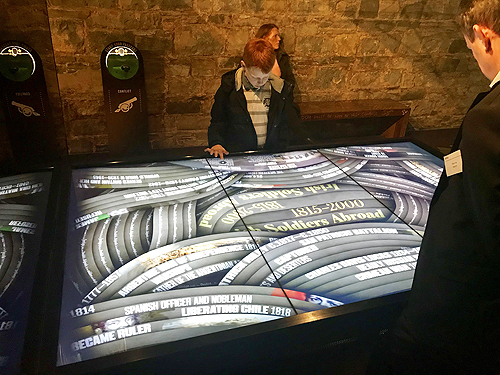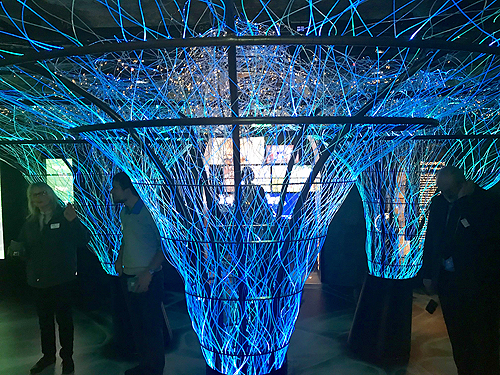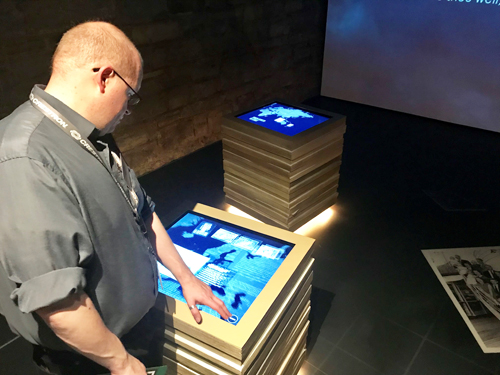AV Helps to Tell the EPIC Story of Irish Emigration
A group of AVIXA members recently gathered in Dublin for a seminar called “Your Best Year Yet,” by Adam Harris, Co-Author of The Check-In Journal. The goal of the session was to learn how to create and achieve your goals, day-by-day, week-by-week, month-by-month. It turns out the setting for the event was serendipitous. If you want to find inspiration for working hard, persevering, and taking risks to achieve your goals, you are sure to find it with a visit to EPIC the Irish Emigration Museum, a new interactive experience located in Dublin’s revitalizing Docklands neighborhood.
 EPIC is an outstanding example of what happens when content, space, and technology come together to create an exceptional experience. The museum utilizes state-of-the-art technology and interactive elements to tell the stories of Irish emigrants
around the world, from 500 A.D. to present day. Exhibits highlight the individual stories of hundreds of Irish emigrants, including notable names like U.S. President John F. Kennedy, Canadian Prime Minister Justin Trudeau, and Gone with the Wind author
Margaret Mitchell.
EPIC is an outstanding example of what happens when content, space, and technology come together to create an exceptional experience. The museum utilizes state-of-the-art technology and interactive elements to tell the stories of Irish emigrants
around the world, from 500 A.D. to present day. Exhibits highlight the individual stories of hundreds of Irish emigrants, including notable names like U.S. President John F. Kennedy, Canadian Prime Minister Justin Trudeau, and Gone with the Wind author
Margaret Mitchell.
The museum opened in May 2016 and has already received international acclaim as the world’s first completely digital museum. The venue was recognized in the Entertainment Venue of the Year category at the 2016 AV Awards.
 Seventy million people globally claim Irish heritage or ancestry and each of them have a unique perspective, as Irish culture has adapted and blended with cultures in destination countries. Visitors
from around the world can experience the museum in a way that’s meaningful to them by selecting their country in the interactive exhibits. The stories are then brought to life through video, images and sound — creating an emotional connection.
Seventy million people globally claim Irish heritage or ancestry and each of them have a unique perspective, as Irish culture has adapted and blended with cultures in destination countries. Visitors
from around the world can experience the museum in a way that’s meaningful to them by selecting their country in the interactive exhibits. The stories are then brought to life through video, images and sound — creating an emotional connection.
Content is presented on various screens, touchscreens, and AV pods where visitors actively swipe and tap to unlock and access information. Visitors become their own guides, creating their own experiences and ultimately become the storyteller. This personalization reinforces one of the larger messages of the museum: The story of Irish emigration is their story.
Applying AV Technology to Make the Museum More Fun … and Educational
“We see technology as being really accessible, for everyone from young to old, and for many different learning styles and levels,” says Thalia Neilson, Assistant Curator at EPIC. For example, the “Changing the Game” gallery presents stories of successful Irish diaspora athletes on interactive disks with QR codes, each one representing a different sport. These are placed on the surface of the table and rotated to cycle through information. “Combining tactile action with the digital medium encourages engagement with the museum’s content,” Neilson explains.
 Another example of using innovative technology to create a more interactive encounter is the “Achieving Infamy” gallery, which portrays the more notorious members of the Irish diaspora, including criminals, pirates, and outlaws.
Visitors physically walk toward the characters presented on the projection screen in front of them, which brings the selected characters to life. The display then presents a factsheet about the characters’ lives, followed by a “Whodunnit?”
game in which visitors can decide whether the character is guilty or not. The visitors body movements are tracked using a Microsoft Xbox Kinect sensor. “The innovative medium of presentation encourages active participation, and makes the
museum experience fun,” says Neilson.
Another example of using innovative technology to create a more interactive encounter is the “Achieving Infamy” gallery, which portrays the more notorious members of the Irish diaspora, including criminals, pirates, and outlaws.
Visitors physically walk toward the characters presented on the projection screen in front of them, which brings the selected characters to life. The display then presents a factsheet about the characters’ lives, followed by a “Whodunnit?”
game in which visitors can decide whether the character is guilty or not. The visitors body movements are tracked using a Microsoft Xbox Kinect sensor. “The innovative medium of presentation encourages active participation, and makes the
museum experience fun,” says Neilson.
Dublin-based video production company Digital Post collaborated with design firm Event Communications to create audiovisual content in the museum. Jim Colgan, Managing Director at Digital Post, explained how the content creators used AV technology to engage visitors with the story.
“ AV tools, such as live-action material (including an array of 2D and 3D FX), 2D graphics, split screening, audio design and rolling text, worked to engage the viewer without distracting them from the powerful images that appeared above,”
he says. “For the live-action films, we used actors to re-enact historical scenes while subtle text appears to carry the viewer through the story.”
AV tools, such as live-action material (including an array of 2D and 3D FX), 2D graphics, split screening, audio design and rolling text, worked to engage the viewer without distracting them from the powerful images that appeared above,”
he says. “For the live-action films, we used actors to re-enact historical scenes while subtle text appears to carry the viewer through the story.”
Choosing the right AV elements and implementing them well was a critical part of the content-creation process. According to Colgan, “Practically, the AV platforms we chose had to strengthen the impact of the piece. For this we considered the positioning of screens, the timing of action on the screens, the sound, color, etc. Unlike some conventional centers, the visitor in EPIC is immersed in an AV experience; literally invited to be part of the story.”
London-based Elbow Productions also contributed content to the project. Louise Reed with Elbow Productions explained how AV choices were critical to the success of a museum with almost no artifacts, “What really struck us from the outset was just how central audiovisual is for this visitor centre. I think there is only one original object in the whole exhibition. AV is used to tell stories both at a macro and micro level, from an impressive 3D Earth tracking global migration over the last 1,500 years, to individual — and often very poignant — stories told via dramatic interpretation.”
The museum’s subject matter posed an exciting challenge for the Elbow Productions team, both intellectually and emotionally. Says Reed, “We want them [visitors] to be surprised, challenged, and inspired to find out more; that’s certainly how we felt when we started developing the content. We were genuinely amazed at just how many global events and personalities on the world stage trace their roots back to Ireland. The AV experience touches on some really hard-hitting topics that feel especially relevant in the current political climate; we hope they’re provocative enough to make an impression on visitors long after they’ve left. Some of the stories were particularly harrowing and from a perspective of organizing this content we were always mindful of the fact that we’re essentially an English company being asked to re-tell Irish history. It was very important for us to engage academics in Irish history early in the project.”
Museum Visitors Crave Experiences
The museum business is changing. Museum-goers increasingly expect to be “wowed.” The days of walking through an exhibit in a predetermined path and spending hours reading blocks of text from walls are numbered.
 EPIC is on the forefront of a trend in the museum sector to include more interactive, tactile, and personalized elements in exhibits and displays. Mark McGowan, Head of Technology
for EPIC, sees this trend as essential to reaching larger and younger audiences. He explained “Many people nowadays engage more readily with information presented digitally than they do with information presented in more traditional
formats. Technology provides a familiar and accessible way to learn for the younger generations, who make up a huge part of the target audience for the sector.”
EPIC is on the forefront of a trend in the museum sector to include more interactive, tactile, and personalized elements in exhibits and displays. Mark McGowan, Head of Technology
for EPIC, sees this trend as essential to reaching larger and younger audiences. He explained “Many people nowadays engage more readily with information presented digitally than they do with information presented in more traditional
formats. Technology provides a familiar and accessible way to learn for the younger generations, who make up a huge part of the target audience for the sector.”
Visitors to EPIC have had positive reactions to the experience. Nielson and McGowan have received compliments and accolades from museum-goers on the visually stunning presentation and the way the accompanying sound makes the experience more “real.” One visitor raved, “It is the perfect combination of art, history and technology to draw people right into the experience of Irish emigration throughout the years.”
In time, this level of digital interaction and AV magic will be what museums are expected to deliver to attract visitors.






